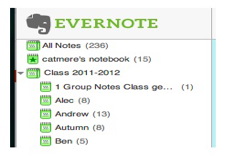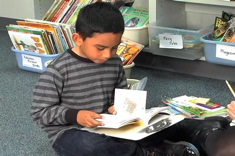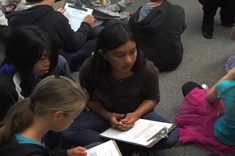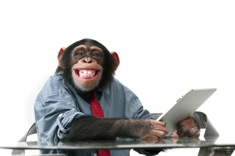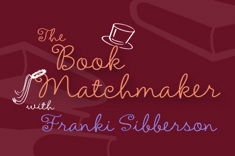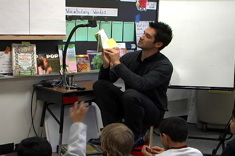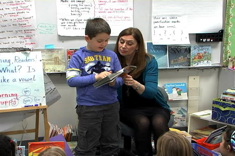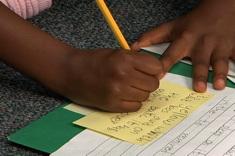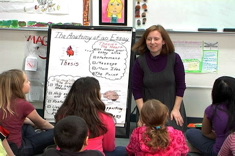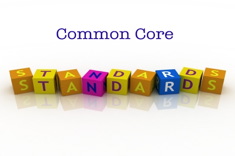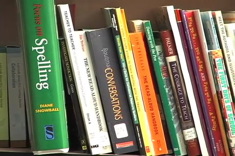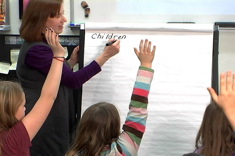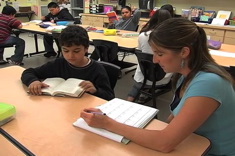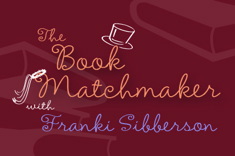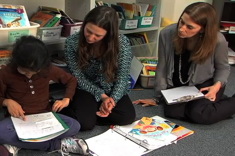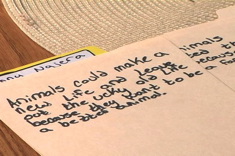Library
Choice Literacy Articles & Videos
The Choice Literacy library contains over 3,000 articles and 900 videos from 150+ contributors. Classic Classroom and Literacy Leadership subscribers have access to the entire library. Content is updated continuously, with five to six new features published each week.
Latest Content
Making Assumptions
The shift from teaching children to mentoring adults can be difficult for many educators. Ellie Gilbert chronicles the biggest assumptions that harm collaborative relationships with colleagues.
Capturing Student Learning with Evernote
It can be difficult to move from print to electronic records in the classroom. After using a spiral notebook for 10 years, Cathy Mere did just that.
Narrative Nonfiction in 5th Grade Part 2
In this lesson from a 5th grade classroom, Aimee Buckner guides students in a note-taking process to help understand the qualities of nonfiction narrative writing. In this second part of the lesson, students share their notes and Aimee makes connections to additional mentor texts.
Words and Images: Mentor Texts for Second Grade Boys
In this conference with two of her second-grade students, Linda Karamatic shares mentor texts and tips to help them with their writing. Both boys are writing stories with strong visual components.
The Sponge Summary Lesson Part 5
In this sequence of videos, Heather teaches a 4th grade class, using the analogy of a sponge to explain how summaries work. In this fifth video, Heather and students shift from “I do” to “we do” as students try test their summary writing skills with partners
Professional Development Openers and Icebreakers (ROUND-UP)
This round-up includes suggestions for opening activities and icebreakers to energize your colleagues from Amanda Adrian, Aimee Buckner, Shari Frost, and Jennifer Jones.
You’ve Got to Be Joking
A first-year teacher struggles to manage a class with boys who are cut-ups. From the lemons to lemonade department, Heather Rader helps him build on student strengths by developing a popular writing unit on joke writing.
Literacy Team Meeting: Focus on Word Work Part 2
In the second part of the literacy team meeting, teachers on the team move from the focus on sharing, to the important phase of where to go next as a team and as a school. Because the crucial work of the team is the work done between meetings, this is a critical discussion.
Book Matchmaker: “Cool” Books for a Struggling Second Grader
Franki Sibberson selects some “cool” books for a struggling reader who wants to fit in with his 2nd grade peers.
Book Matchmaker: Global Citizenship and Social Responsibility
Here are some newer books for teaching students about social responsibility and what it means to be a citizen of the world.
Nonfiction Read Aloud
Sean Moore reads nonfiction aloud to his 2nd grade students. This is the first video in a two-part series.
Tried and True Trumps Shiny and New
Amanda Adrian explains why running records are still an essential tool in any teacher’s assessment arsenal. She also includes links to web resources for honing your running record skills if they are a bit rusty.
From “I Don’t Get It” to “Never Mind — That’s Amazing!”: Scaffolding Schema for Comprehending Poetry
Katie Doherty finds poetry is a powerful tool for helping her middle school students understand the value of schema while reading.
Nonfiction Read Aloud – Part 2
Here are some more tips for nonfiction read-alouds, based on Sean Moore's reading of Plants That Eat Animals.
The Sponge Summary Lesson Part 6
In this sequence of videos, Heather teaches a 4th grade class, using the analogy of a sponge to explain how summaries work. In this final video, Heather and students debrief and capture their learning in writing.
Book Matchmaker: Wordless Picture Books
Brad Smedley, an elementary principal, is looking for wordless picture books to share with his preschool classes.
Rumor Has It
Lisa Koch says we should get our students to start some rumors — about characters, that is.
Astrigs, Asterisks, and Letting Students Lead
In this video from Linda Karamatic’s second-grade classroom, Charlie shares his punctuation “find” of asterisks with his classmates. He is reading the book Miss Child Has Gone Wild by Dan Gutman.
Sticky Little Invention (The Post-It Essay)
Jill Ostrow describes how the "post-it essay" is an ingenious way to get richer responses to displays of learning. Jill is working with teachers, but this is another writing activity that can be adapted for use with teens or tweens.
Essay Writing: Thesis Statements and Supporting Details Minilesson
Beth Lawson works with her 4th graders to develop essays with strong thesis statements and supporting details, using a folder organization system to highlight different thesis statements for each child. This is the first video in a series.
Common Core Conversations: Text Complexity
Amanda Adrian and Heather Rader find ways into understanding text complexity with students and teachers.
I Can’t Quite Put My Finger On It
Have you ever had a teacher enthusiastically embrace a new “magic bullet” instructional program that includes scripted or rote elements that concern you? Melanie Quinn considers this sticky situation instructional coaches sometimes find themselves in, and comes up with some starting points for conversations with colleagues.
Essay Writing: Teacher Modeling
Beth Lawson works with her fourth graders to develop essays with strong thesis statements and supporting details, using a folder organization system to highlight different thesis statements for each child. This is the second video in a series.
Conferring with Tweens: Boys and Series Books
In this conference from a 6th grade classroom, Katie Doherty confers with a boy who is reading a book from a series she is unfamiliar with – watch how she engages the child to learn about the series and refocus the discussion on skills and goals.
Noticing Words in Second Grade
In this brief video from Linda Karamatic’s 2nd grade classroom, students share words they are noticing, and Linda talks about making revisions to the wall displays of words in the classroom. She also mentions the word “wretched” which the class discussed the previous day, and how the word might be used naturally in conversations.
Book Matchmaker: Picture Book Biographies
Franki Sibberson shares some of her favorite picture book biographies in the latest installment of Book Matchmaker.
Same Old Love Song — A Cento
Shirl McPhillips creates a cento – a collection of lines written by other poets compiled into a new poem. It turns out poets were sampling other creative works centuries before rappers made the practice so popular today.
Listen In: Writing in Math
Heather Rader confers with 2nd grader Maya about her math writing as Linda Karamatic listens in.
Conferring About Thesis Statements
In this conference with a 4th grader, Beth Lawson talks about supporting details for thesis statements. This is part of the video series from Beth’s room on essay writing.
Write Today
Ruth Ayres describes her own experiences as an author, blogger, and teacher. She shows how possible and essential writing is for even the busiest educators.
Browse Content By
Type
Category
- Assessment Tools
- Big Fresh Archives
- Booklists
- Choice Numeracy
- Classroom Design
- Common Core
- Community Building
- Conferring
- Content Literacy
- Digital Literacy
- English Language Learners
- Equity
- Family Relations
- Free Samples
- Guiding Groups
- Leadership
- Literacy Coaches
- Mentor Texts
- Minilessons
- New Teacher Mentors
- Podcasts
- Poetry
- Quote Collections
- Reading Strategies
- Self Care
- Struggling and Striving Learners
- Talking and Listening
- Teacher Study Groups
- Teaching Reading
- Teaching Writing
- Word Study and Vocabulary
Author
- Melissa Quimby
- Nawal Qarooni
- Gwen Blumberg
- Julie Cox
- The Lead Learners
- Hannah Tills
- Josie Stewart
- Ruth Metcalfe
- Mallory Messenger
- Becca Burk
- Jodie Bailey
- Vivian Chen
- Mary Brower
- Tiffany Abbott Fuller
- Stephanie Affinito
- Ruth Ayres
- Leigh Anne Eck
- Heather Fisher
- Shari Frost
- Julie Johnson
- Suzy Kaback
- Gigi McAllister
- Shirl McPhillips
- Melanie Meehan
- Cathy Mere
- Debbie Miller
- Tara Barnett and Kate Mills
- Tammy Mulligan
- Dana Murphy
- Bitsy Parks
- David Pittman
- Brenda Power
- Heather Rader
- Matt Renwick
- Mandy Robek
- Christy Rush-Levine
- Gretchen Schroeder
- Jen Schwanke
- Brian Sepe
- Katherine Sokolowski
- Stella Villalba
- Jennifer Vincent
Grade Level
Choice Literacy Membership
Articles
Get full access to all Choice Literacy article content
Videos
Get full access to all Choice Literacy video content
Courses
Access Choice Literacy course curriculum and training


